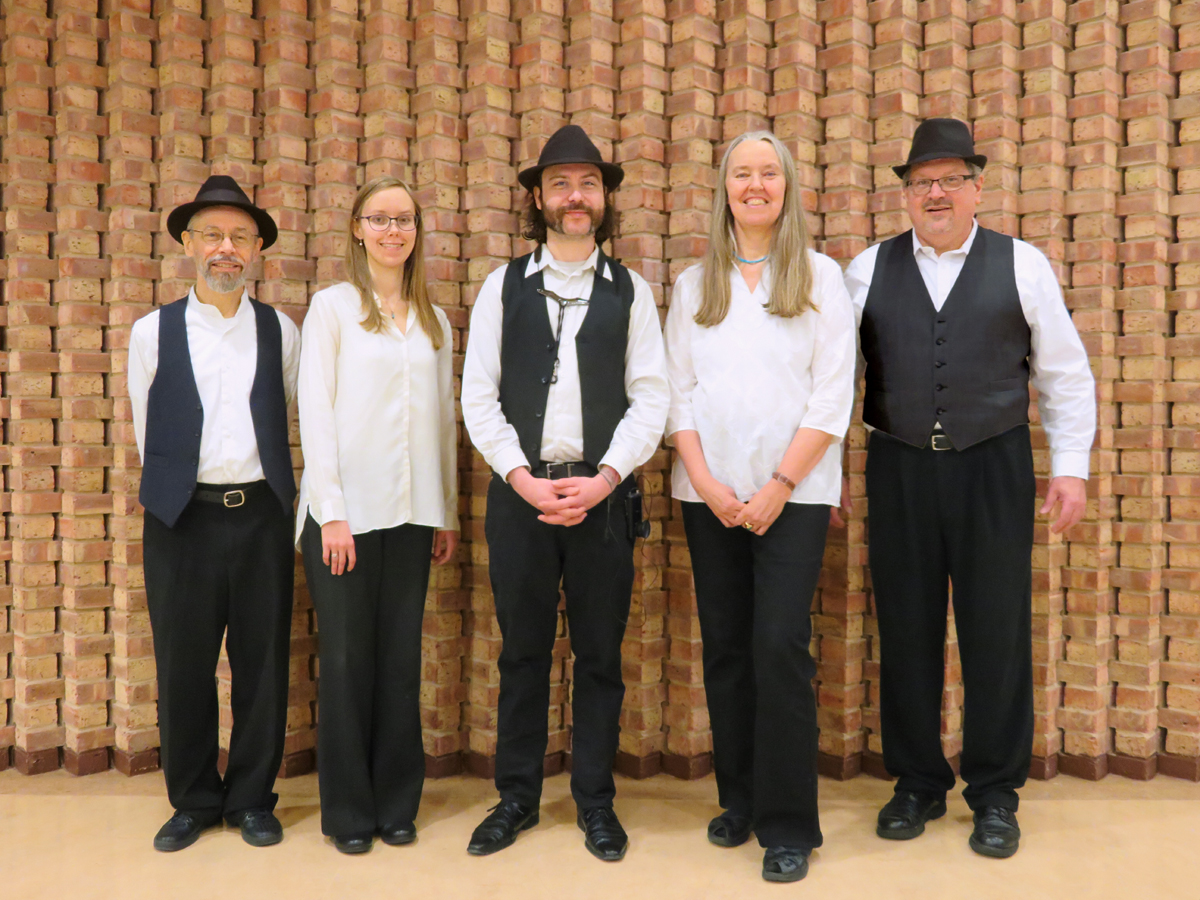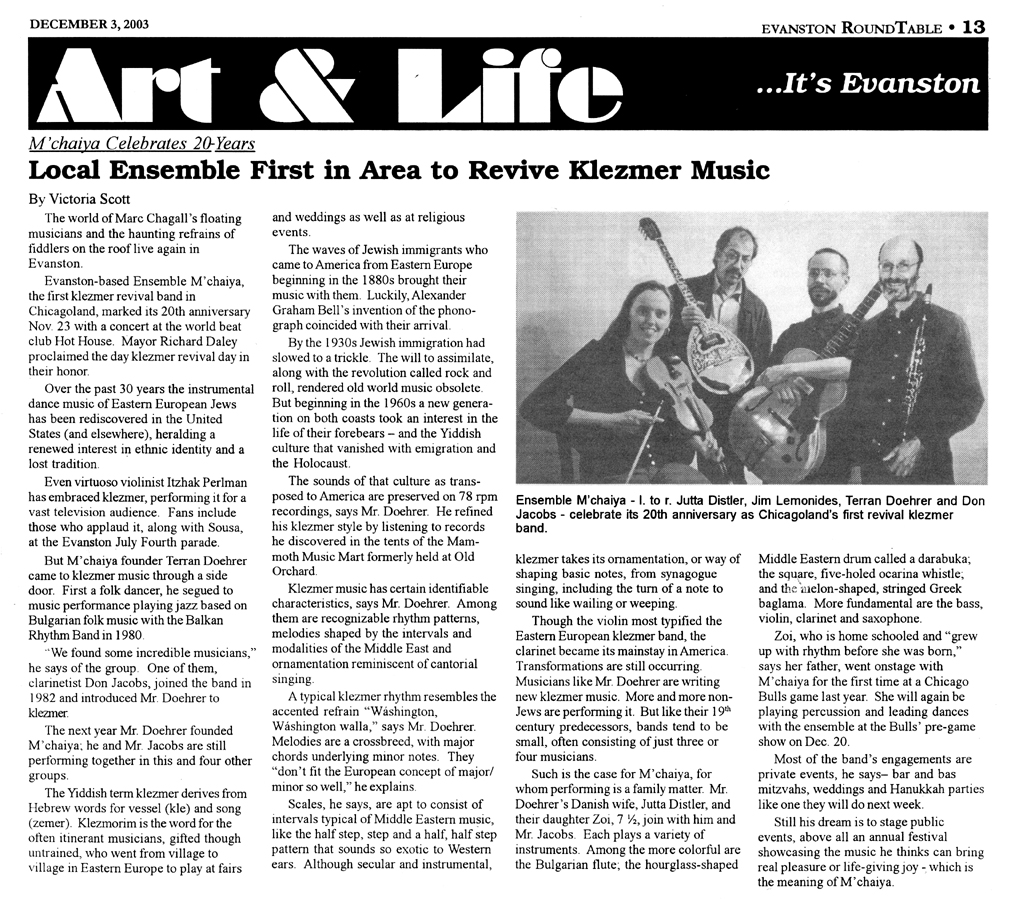ENSEMBLE
M’CHAIYA

M’chaiya Celebrates 20 Years
Local Ensemble First in Area to Revive Klezmer Music
Evanston Round Table — Art and Life section, by Victoria Scott, December 3, 2003.

The world of Marc Chagall’s floating musicians and the haunting refrains of fiddlers on the roof live again in Evanston.
Evanston-based Ensemble M’chaiya, the first klezmer revival band in Chicagoland, marked its 20th anniversary Nov. 23 with a concert at the world beat club Hot House. Mayor Richard Daley proclaimed the day klezmer revival day in their honor.
Over the past 30 years the instrumental dance music of Eastern European Jews has been rediscovered in the United States (and elsewhere), heralding a renewed interest in ethnic identity and a lost tradition.
Even virtuoso violinist Itzhak Perlman has embraced klezmer, performing it for a vast television audience. Fans include those who applaud it, along with Sousa, at the Evanston July Fourth parade.
But M’chaiya founder Terran Doehrer came to klezmer music through a side door. First a folk dancer, he segued to music performance playing jazz based on Bulgarian folk music with the Balkan Rhythm Band in 1980.
“We found some incredible musicians,” he says of the group. One of them, clarinetist Don Jacobs, joined the band in 1982 and introduced Mr. Doehrer to klezmer.
The next year Mr. Doehrer founded M’chaiya; he and Mr. Jacobs are still performing together in this and four other groups.
The Yiddish term klezmer derives from Hebrew words for vessel (kle) and song (zemer). Klezmorim is the word for the often itinerant musicians, gifted though untrained, who went from village to village in Eastern Europe to play at fairs and weddings as well as at religious events.
The waves of Jewish immigrants who came to America from Eastern Europe beginning in the 1880s brought their music with them. Luckily, Alexander Graham Bell’s invention of the phonograph coincided with their arrival.
By the 1930s Jewish immigration had slowed to a trickle. The will to assimilate, along with the revolution called rock and roll, rendered old world music obsolete. But beginning in the 1960s a new generation on both coasts took an interest in the life of their forebears – and the Yiddish culture that vanished with emigration and the Holocaust.
The sounds of that culture as transposed to America are preserved on 78 rpm recordings, says Mr. Doehrer. He refined his klezmer style by listening to records he discovered in the tents of the Mammoth Music Mart formerly held at Old Orchard.
Klezmer music has certain identifiable characteristics, says Mr. Doehrer. Among them are recognizable rhythm patterns, melodies shaped by the intervals and modalities of the Middle East and ornamentation reminiscent of cantorial singing.
A typical klezmer rhythm resembles the accented refrain “Washington, Washington walla,” says Mr. Doehrer. Melodies are a crossbreed, with major chords underlying minor notes. They “don’t fit the European concept of major/minor so well,” he explains.
Scales, he says, are apt to consist of intervals typical of Middle Eastern music, like the half step, step and a half, half step pattern that sounds so exotic to Western ears. Although secular and instrumental, klezmer takes its ornamentation, or way of shaping basic notes, from synagogue singing, including the turn of a note to sound like wailing or weeping.
Though the violin most typified the Eastern European klezmer band, the clarinet became its mainstay in America.
Transformations are still occurring. Musicians like Mr. Doehrer are writing new klezmer music. More and more non-Jews are performing it. But like their 19th century predecessors, bands tend to be small, often consisting of just three or four musicians.
Such is the case for M’chaiya, for whom performing is a family matter. Mr. Doehrer’s Danish wife, Jutta Distler, and their daughter Zoi, seven, join with him and Mr. Jacobs. Each plays a variety of instruments. Among the more colorful are the Bulgarian flute; the hourglass-shaped Middle Eastern drum called a darabuka; the square, five-holed ocarina whistle; and the melon-shaped, stringed Greek baglama. More fundamental are the bass, violin, clarinet and saxophone.
Zoi, who is home schooled and “grew up with rhythm before she was born,” says her father, went onstage with M’chaiya for the first time at a Chicago Bulls game last year. She will again be playing percussion and leading dances with the ensemble at the Bulls’ pre-game show on Dec. 20.
Most of the band’s engagements are private events, he says” bar and bas mitzvahs, weddings and Hanukkah parties like one they will do next week.
Still his dream is to stage public events, above all an annual festival showcasing the music he thinks can bring real pleasure or life-giving joy — which is the meaning of M’chaiya.